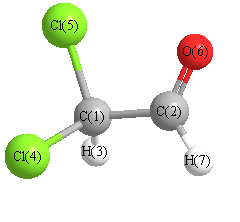Jump to
S1C2
Vibrational Frequencies calculated at CCSD/6-31G(2df,p)
Geometric Data calculated at CCSD/6-31G(2df,p)
Electronic energy levels
Charges, Dipole, Quadrupole and Polarizability
Jump to
S1C1
Energy calculated at CCSD/6-31G(2df,p)
| | hartrees |
|---|
| Energy at 0K | -1071.640835 |
| Energy at 298.15K | |
| HF Energy | -1070.723056 |
| Nuclear repulsion energy | 266.799466 |
The energy at 298.15K was derived from the energy at 0K
and an integrated heat capacity that used the calculated vibrational frequencies.
Vibrational Frequencies calculated at CCSD/6-31G(2df,p)
| Mode Number |
Symmetry |
Frequency
(cm-1) |
Scaled Frequency
(cm-1) |
IR Intensities
(km mol-1) |
Raman Act
(Å4/u) |
Dep P |
Dep U |
|---|
| 1 |
A |
3168 |
2996 |
3.57 |
|
|
|
| 2 |
A |
3026 |
2861 |
38.96 |
|
|
|
| 3 |
A |
1871 |
1769 |
102.66 |
|
|
|
| 4 |
A |
1427 |
1350 |
15.03 |
|
|
|
| 5 |
A |
1300 |
1229 |
10.67 |
|
|
|
| 6 |
A |
1254 |
1185 |
14.42 |
|
|
|
| 7 |
A |
1059 |
1001 |
12.73 |
|
|
|
| 8 |
A |
963 |
910 |
6.63 |
|
|
|
| 9 |
A |
859 |
812 |
70.06 |
|
|
|
| 10 |
A |
668 |
632 |
28.96 |
|
|
|
| 11 |
A |
634 |
599 |
29.14 |
|
|
|
| 12 |
A |
352 |
333 |
1.09 |
|
|
|
| 13 |
A |
280 |
264 |
3.43 |
|
|
|
| 14 |
A |
225 |
213 |
2.90 |
|
|
|
| 15 |
A |
92 |
87 |
9.89 |
|
|
|
Unscaled Zero Point Vibrational Energy (zpe) 8588.2 cm
-1
Scaled (by 0.9455) Zero Point Vibrational Energy (zpe) 8120.2 cm
-1
See section
III.C.1 List or set vibrational scaling factors
to change the scale factors used here.
See section
III.C.2
Calculate a vibrational scaling factor for a given set of molecules
to determine the least squares best scaling factor.
Geometric Data calculated at CCSD/6-31G(2df,p)
Point Group is C1
Cartesians (Å)
| Atom |
x (Å) |
y (Å) |
z (Å) |
|---|
| C1 |
0.102 |
-0.026 |
0.523 |
| C2 |
-0.716 |
-1.279 |
0.195 |
| H3 |
0.232 |
0.058 |
1.602 |
| Cl4 |
1.728 |
-0.262 |
-0.170 |
| Cl5 |
-0.668 |
1.443 |
-0.057 |
| O6 |
-1.796 |
-1.263 |
-0.319 |
| H7 |
-0.202 |
-2.210 |
0.491 |
Atom - Atom Distances (Å)
| |
C1 |
C2 |
H3 |
Cl4 |
Cl5 |
O6 |
H7 |
| C1 | | 1.5320 | 1.0892 | 1.7830 | 1.7577 | 2.4175 | 2.2051 |
C2 | 1.5320 | | 2.1593 | 2.6722 | 2.7343 | 1.1961 | 1.1040 | H3 | 1.0892 | 2.1593 | | 2.3408 | 2.3411 | 3.0895 | 2.5620 | Cl4 | 1.7830 | 2.6722 | 2.3408 | | 2.9431 | 3.6665 | 2.8202 | Cl5 | 1.7577 | 2.7343 | 2.3411 | 2.9431 | | 2.9440 | 3.7233 | O6 | 2.4175 | 1.1961 | 3.0895 | 3.6665 | 2.9440 | | 2.0231 | H7 | 2.2051 | 1.1040 | 2.5620 | 2.8202 | 3.7233 | 2.0231 | |
 More geometry information
More geometry information
Calculated Bond Angles
| atom1 |
atom2 |
atom3 |
angle |
|
atom1 |
atom2 |
atom3 |
angle |
| C1 |
C2 |
O6 |
124.323 |
|
C1 |
C2 |
H7 |
112.540 |
| C2 |
C1 |
H3 |
109.774 |
|
C2 |
C1 |
Cl4 |
107.192 |
| C2 |
C1 |
Cl5 |
112.253 |
|
H3 |
C1 |
Cl4 |
106.667 |
| H3 |
C1 |
Cl5 |
108.345 |
|
Cl4 |
C1 |
Cl5 |
112.450 |
| O6 |
C2 |
H7 |
123.137 |
|
Electronic energy levels
Charges, Dipole, Quadrupole and Polarizability
